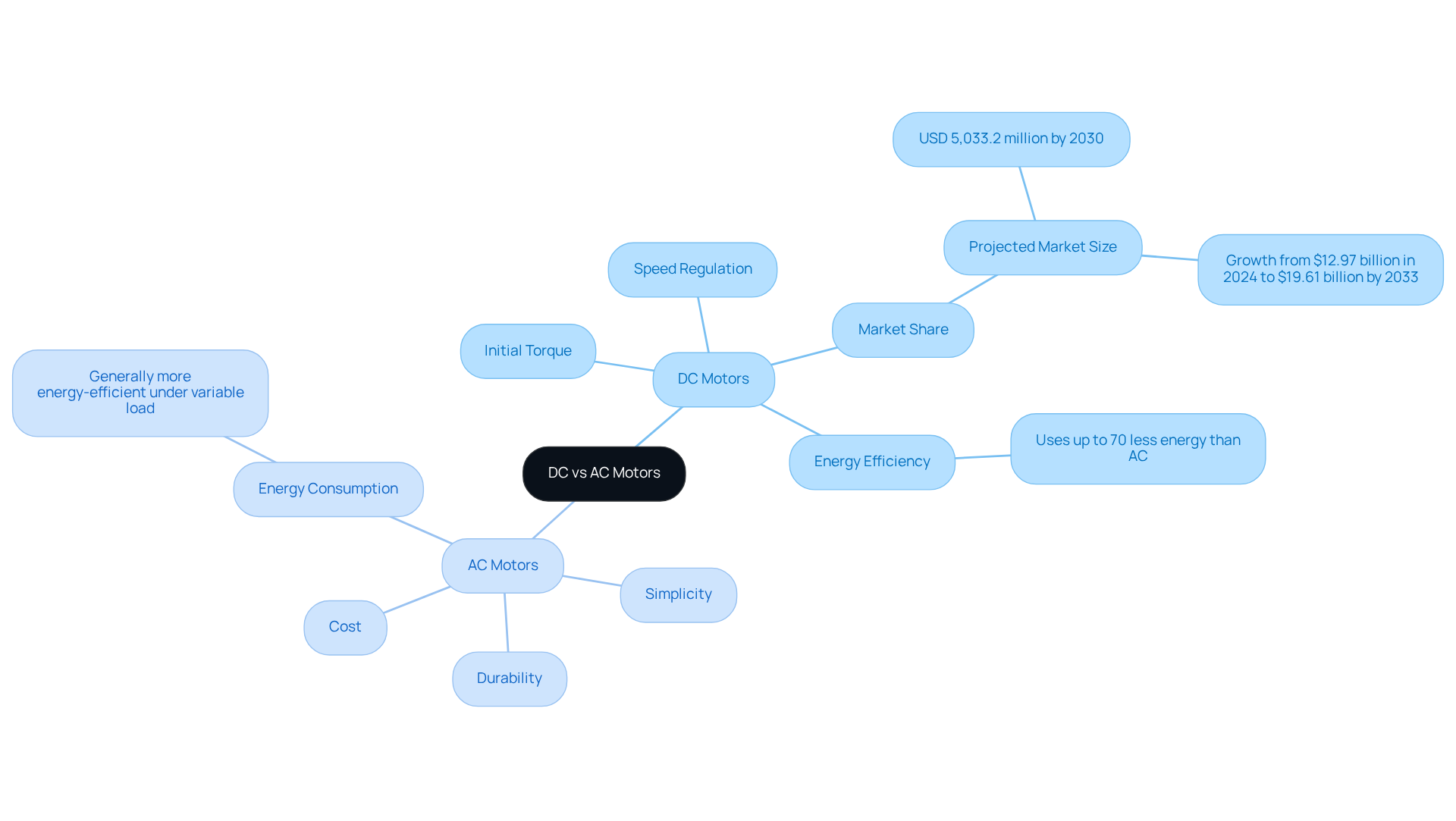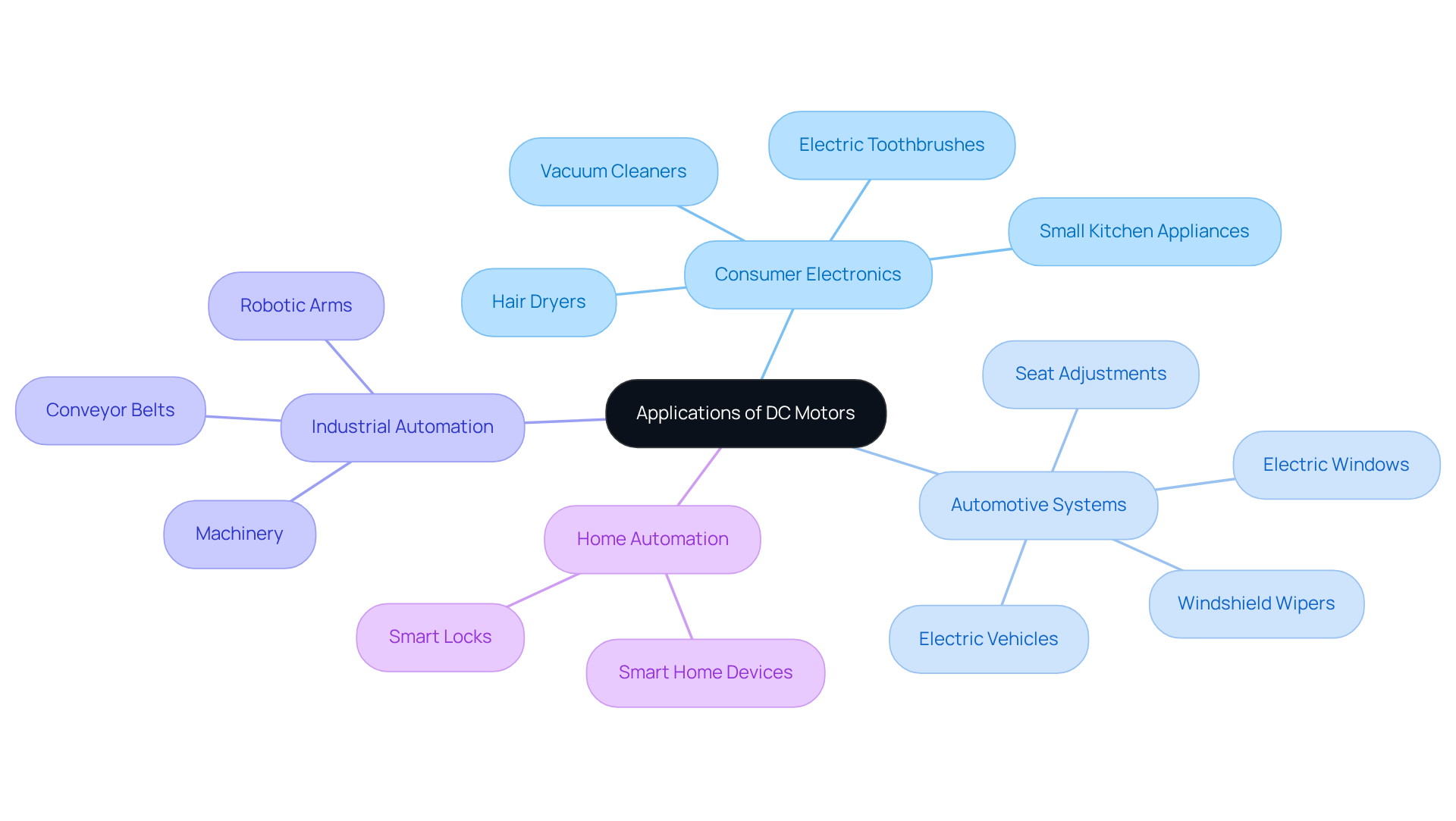Introduction
Understanding the mechanics behind ceiling fans is crucial for electronics engineers, especially as the demand for energy-efficient solutions continues to grow. This article explores the advantages of fan DC motors over traditional AC motors, emphasizing their increasing prevalence in modern designs. However, with the promise of enhanced performance and efficiency, engineers must navigate several challenges when integrating this technology into their projects.
As we delve deeper into the intricacies of DC motors, it becomes evident that their benefits extend beyond mere energy savings. These motors offer superior control, quieter operation, and longer lifespans, making them an attractive choice for contemporary applications. Yet, the transition from AC to DC technology is not without its hurdles. Engineers must consider factors such as cost, compatibility with existing systems, and the need for specialized knowledge in motor control.
In the following sections, we will examine these challenges in detail, providing actionable insights and solutions to help engineers successfully implement DC motors in their designs. By understanding both the advantages and the obstacles, professionals can make informed decisions that align with the growing demand for efficiency in the industry.
Explore the Basics of DC Motors in Ceiling Fans
DC devices, or direct current machines, utilize direct current electricity, which flows in a single direction. In ceiling fans, these mechanisms are typically brushless, resulting in fewer moving components. This design leads to less wear and tear, ultimately extending the lifespan of the device. The fundamental components of a DC device include:
- A rotor (the rotating part)
- A stator (the stationary part)
- A commutator that facilitates the direction change of current, enabling continuous rotation
Understanding these elements is essential for engineers focused on enhancing fan performance and efficiency.
For example, a standard fan DC motor in a ceiling fan can achieve greater torque at lower speeds compared to its AC counterparts. This characteristic makes it ideal for applications that require quiet operation and energy conservation. Such efficiency is particularly crucial in residential environments where noise reduction is a priority.
In summary, the integration of fan DC motor technology in ceiling fans not only enhances performance but also meets the growing demand for energy-efficient solutions. Engineers and manufacturers should consider these advantages when designing and selecting fan systems.

Compare DC and AC Motors: Key Technical Differences
DC and AC machines exhibit fundamental differences in operation and application, which are crucial for engineers to understand. DC devices utilize direct current, enabling precise speed regulation and delivering greater initial torque. This makes fan DC motors ideal for applications that require variable speed, such as overhead appliances with adjustable airflow options. In fact, approximately 30% of ceiling fans now incorporate fan DC motor technology, reflecting its growing popularity in the market. The market for fan DC motors is projected to reach USD 5,033.2 million by 2030, highlighting the increasing acceptance of DC technology in this sector.
On the other hand, AC devices operate on alternating current and are generally simpler and more durable, making them a preferred choice for larger appliances. However, they often lack the fine control and energy efficiency that direct current devices provide. For example, DC devices can consume up to 70% less energy than their AC counterparts for the same output, significantly reducing operational costs and environmental impact. The fan DC motor market size is expected to grow from $12.97 billion in 2024 to $19.61 billion by 2033, with a CAGR of 4.7%, indicating a shift towards energy-efficient solutions like DC drives.
Industry leaders emphasize the advantages of fan DC motors, noting that their capability to operate quietly and efficiently aligns with modern energy-saving initiatives. As Gainesville Industrial Electrical highlights, selecting the right motor is vital for productivity. While AC devices may be less expensive and easier to maintain, the long-term benefits of DC systems – particularly in energy consumption and performance – make them an attractive option for engineers committed to sustainability and efficiency. Understanding these distinctions is essential for engineers to make informed decisions tailored to the specific needs of their projects.

Evaluate the Advantages of DC Motors in Ceiling Fans
DC motors present a range of advantages when utilized in ceiling fans, making them a superior choice in today’s market:
-
Energy Efficiency: DC machines can consume up to 70% less energy compared to conventional AC devices. This significant reduction in energy usage translates to lower electricity costs over time, appealing to both environmentally conscious consumers and those looking to save on utility bills.
-
Quieter Operation: The design of DC devices minimizes noise, rendering them ideal for residential environments where silent operation is essential. This feature enhances the comfort of living spaces, allowing for a peaceful atmosphere.
-
Enhanced Control: DC machines provide smoother speed regulation, which is crucial for achieving the desired airflow. Furthermore, their compatibility with smart home systems allows for convenient remote operation, catering to the modern homeowner’s needs.
-
Lightweight Design: The compact nature of DC devices facilitates more streamlined fan designs. This not only simplifies installation but also reduces the structural demands on ceilings, making them a practical choice for various settings.
These compelling benefits position the fan DC motor as a leading option in contemporary fan designs, aligning seamlessly with the industry’s commitment to energy efficiency and user-friendly innovations.

Discover Applications of DC Motors in Electronics
Fan DC motors play a crucial role in a variety of applications beyond just ceiling fans. Their versatility is evident in several key areas:
- Consumer Electronics: Devices like electric toothbrushes, hair dryers, and vacuum cleaners depend on DC motors for their efficiency and compact design.
- Automotive Systems: In vehicles, DC drives are essential for electric windows, windshield wipers, and seat adjustments, providing reliable performance.
- Industrial Automation: Within manufacturing, DC motors power conveyor belts, robotic arms, and other machinery, enabling streamlined operations.
- Home Automation: Smart home devices frequently utilize DC motors due to their ability to deliver precise control and energy efficiency.
These applications underscore the importance of fan DC motors, establishing them as vital components in both consumer and industrial electronics.

Conclusion
The exploration of fan DC motors underscores their vital role in boosting the efficiency and performance of ceiling fans and various electronic devices. Understanding the unique characteristics and advantages of these motors empowers engineers to make informed decisions that meet the modern demands for energy efficiency and quiet operation.
Key insights reveal significant differences between DC and AC motors, particularly regarding energy consumption, operational noise, and control capabilities. DC motors can deliver up to 70% energy savings, and their quiet performance, combined with adaptability to smart home technologies, positions them as the superior choice for contemporary applications. Their versatility extends beyond ceiling fans, influencing sectors such as consumer electronics, automotive systems, and industrial automation.
As the market for fan DC motors continues to grow, it is imperative for electronics engineers to embrace advancements in this technology. By prioritizing the integration of DC motors into their designs, engineers can contribute to a more energy-efficient and sustainable future while addressing the evolving needs of consumers. The shift towards DC technology not only enhances product performance but also aligns with broader environmental goals, making it a crucial consideration in today’s engineering landscape.
Frequently Asked Questions
What is a DC motor?
A DC motor, or direct current motor, is a device that utilizes direct current electricity, which flows in a single direction.
How are DC motors in ceiling fans designed?
DC motors in ceiling fans are typically brushless, resulting in fewer moving components, which leads to less wear and tear and extends the lifespan of the device.
What are the fundamental components of a DC motor?
The fundamental components of a DC motor include a rotor (the rotating part), a stator (the stationary part), and a commutator that facilitates the direction change of current for continuous rotation.
What advantages do DC motors offer in ceiling fans?
DC motors can achieve greater torque at lower speeds compared to AC motors, making them ideal for applications that require quiet operation and energy conservation.
Why is the efficiency of DC motors important in residential environments?
The efficiency of DC motors is crucial in residential environments because it contributes to noise reduction and energy conservation, which are important for comfortable living spaces.
What should engineers and manufacturers consider when designing fan systems?
Engineers and manufacturers should consider the advantages of DC motor technology, including enhanced performance and energy efficiency, when designing and selecting fan systems.

